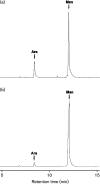Structural characterization of a partially arabinosylated lipoarabinomannan variant isolated from a Corynebacterium glutamicum ubiA mutant
- PMID: 17660426
- PMCID: PMC2884958
- DOI: 10.1099/mic.0.2007/008078-0
Structural characterization of a partially arabinosylated lipoarabinomannan variant isolated from a Corynebacterium glutamicum ubiA mutant
Abstract
Arabinan polysaccharide side-chains are present in both Mycobacterium tuberculosis and Corynebacterium glutamicum in the heteropolysaccharide arabinogalactan (AG), and in M. tuberculosis in the lipoglycan lipoarabinomannan (LAM). This study shows by quantitative sugar and glycosyl linkage analysis that C. glutamicum possesses a much smaller LAM version, Cg-LAM, characterized by single t-Araf residues linked to the alpha(1-->6)-linked mannan backbone. MALDI-TOF MS showed an average molecular mass of 13,800-15 400 Da for Cg-LAM. The biosynthetic origin of Araf residues found in the extracytoplasmic arabinan domain of AG and LAM is well known to be provided by decaprenyl-monophosphoryl-D-arabinose (DPA). However, the characterization of LAM in a C. glutamicum : : ubiA mutant devoid of prenyltransferase activity and devoid of DPA-dependent arabinan deposition into AG revealed partial formation of LAM, albeit with a slightly altered molecular mass. These data suggest that in addition to DPA utilization as an Araf donor, alternative pathways exist in Corynebacterianeae for Araf delivery, possibly via an unknown sugar nucleotide.
Figures






Similar articles
-
Deletion of Cg-emb in corynebacterianeae leads to a novel truncated cell wall arabinogalactan, whereas inactivation of Cg-ubiA results in an arabinan-deficient mutant with a cell wall galactan core.J Biol Chem. 2005 Sep 16;280(37):32362-71. doi: 10.1074/jbc.M506339200. Epub 2005 Jul 21. J Biol Chem. 2005. PMID: 16040600
-
Arabinan-deficient mutants of Corynebacterium glutamicum and the consequent flux in decaprenylmonophosphoryl-D-arabinose metabolism.Glycobiology. 2006 Nov;16(11):1073-81. doi: 10.1093/glycob/cwl030. Epub 2006 Aug 4. Glycobiology. 2006. PMID: 16891347
-
Identification of an alpha(1-->6) mannopyranosyltransferase (MptA), involved in Corynebacterium glutamicum lipomanann biosynthesis, and identification of its orthologue in Mycobacterium tuberculosis.Mol Microbiol. 2007 Sep;65(6):1503-17. doi: 10.1111/j.1365-2958.2007.05884.x. Epub 2007 Aug 21. Mol Microbiol. 2007. PMID: 17714444 Free PMC article.
-
Mycobacterial lipoarabinomannan: an extraordinary lipoheteroglycan with profound physiological effects.Glycobiology. 1998 Feb;8(2):113-20. doi: 10.1093/glycob/8.2.113. Glycobiology. 1998. PMID: 9451020 Review.
-
Carbohydrate metabolism in Corynebacterium glutamicum and applications for the metabolic engineering of L-lysine production strains.Appl Microbiol Biotechnol. 2010 May;86(5):1313-22. doi: 10.1007/s00253-010-2537-z. Epub 2010 Mar 24. Appl Microbiol Biotechnol. 2010. PMID: 20333512 Review.
Cited by
-
Lipoarabinomannan and related glycoconjugates: structure, biogenesis and role in Mycobacterium tuberculosis physiology and host-pathogen interaction.FEMS Microbiol Rev. 2011 Nov;35(6):1126-57. doi: 10.1111/j.1574-6976.2011.00276.x. Epub 2011 May 31. FEMS Microbiol Rev. 2011. PMID: 21521247 Free PMC article. Review.
-
Benzothiazinones mediate killing of Corynebacterineae by blocking decaprenyl phosphate recycling involved in cell wall biosynthesis.J Biol Chem. 2014 Feb 28;289(9):6177-87. doi: 10.1074/jbc.M113.522623. Epub 2014 Jan 20. J Biol Chem. 2014. PMID: 24446451 Free PMC article.
-
The conserved σD envelope stress response monitors multiple aspects of envelope integrity in corynebacteria.PLoS Genet. 2024 Jun 3;20(6):e1011127. doi: 10.1371/journal.pgen.1011127. eCollection 2024 Jun. PLoS Genet. 2024. PMID: 38829907 Free PMC article.
-
Cell wall glycolipids from Corynebacterium pseudotuberculosis strains with different virulences differ in terms of composition and immune recognition.Braz J Microbiol. 2020 Dec;51(4):2101-2110. doi: 10.1007/s42770-020-00343-9. Epub 2020 Jul 25. Braz J Microbiol. 2020. PMID: 32712830 Free PMC article.
-
Distinct CD1d docking strategies exhibited by diverse Type II NKT cell receptors.Nat Commun. 2019 Nov 20;10(1):5242. doi: 10.1038/s41467-019-12941-9. Nat Commun. 2019. PMID: 31748533 Free PMC article.
References
-
- Alderwick, L. J., Radmacher, E., Seidel, M., Gande, R., Hitchen, P. G., Morris, H. R., Dell, A., Sahm, H., Eggeling, L. & Besra, G. S. (2005). Deletion of Cg-emb in Corynebacterianeae leads to a novel truncated cell wall arabinogalactan, whereas inactivation of Cg-ubiA results in an arabinan-deficient mutant with a cell wall galactan core. J Biol Chem 280, 32362–32371. - PubMed
-
- Alderwick, L. J., Dover, L. G., Seidel, M., Gande, R., Sahm, H., Eggeling, L. & Besra, G. S. (2006a). Arabinan-deficient mutants of Corynebacterium glutamicum and the consequent flux in decaprenylmonophosphoryl-d-arabinose metabolism. Glycobiology 16, 1073–1081. - PubMed
-
- Alderwick, L. J., Seidel, M., Sahm, H., Besra, G. S. & Eggeling, L. (2006b). Identification of a novel arabinofuranosyltransferase (AftA) involved in cell wall arabinan biosynthesis in Mycobacterium tuberculosis. J Biol Chem 281, 15653–15661. - PubMed
-
- Belanger, A. E., Besra, G. S., Ford, M. E., Mikusova, K., Belisle, J. T., Brennan, P. J. & Inamine, J. M. (1996). The embAB genes of Mycobacterium avium encode an arabinosyl transferase involved in cell wall arabinan biosynthesis that is the target for the antimycobacterial drug ethambutol. Proc Natl Acad Sci U S A 93, 11919–11924. - PMC - PubMed
-
- Berg, S., Starbuck, J., Torrelles, J. B., Vissa, V. D., Crick, D. C., Chatterjee, D. & Brennan, P. J. (2005). Roles of conserved proline and glycosyltransferase motifs of EmbC in biosynthesis of lipoarabinomannan. J Biol Chem 280, 5651–5663. - PubMed
Publication types
MeSH terms
Substances
Grants and funding
LinkOut - more resources
Full Text Sources
Molecular Biology Databases
Miscellaneous

